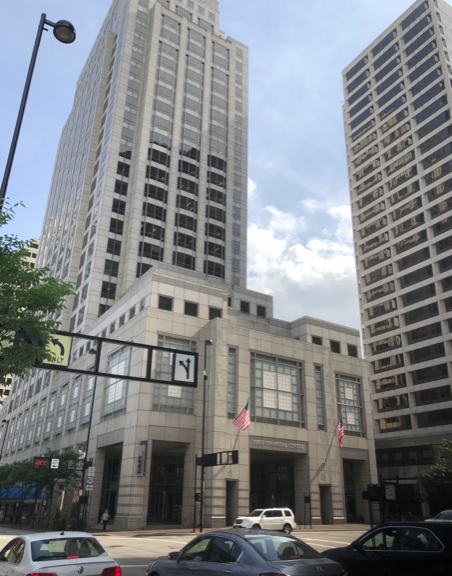What will become of our empty office towers?
Kathy Holwadel is a Strong Towns member sharing today's guest article about the fate of downtown office buildings.
This is the skyline of my hometown, Cincinnati, Ohio, in the 1940s.
Source: The Public Library of Cincinnati and Hamilton County
Here it is again more recently, the picture of modern day urban prosperity — dotted with the office towers we have all come to associate with high-paying corporate jobs and economic success at the turn of the twenty-first century.
Yes, this is what progress looked like. As the power of big corporations grew, so did their need for vertical dominance in the skylines of American cities. The attractiveness of a municipality was directly proportional to how many towers it built. More towers meant more big corporations and more big corporations meant more good jobs. More good jobs meant more income taxes, which was supposed to translate into a better quality of life for everybody, including poorer folks who get their hands dirty down on street level. It was taxpayer-subsidized trickle-down economics in steel and glass.
And it kind of worked. For a while. But, no matter how strong they look, these towers, like all the towers built throughout history, are not immune to the forces of change.
Take for instance Columbia Plaza at 250 E. Fifth. It’s 29 stories and was built in 1984.
In 2011, the biggest tenant was lured with generous tax incentives to another city in the south. They vacated the top six floors and, seven years later, 40% of the building is still empty. A New York investment company bought the property out of foreclosure, invested over $12 million in a new lobby and improved amenities. We’re all hoping for the best.
Or we could walk across the street to the First Financial Center with 32 floors, built in 1991.
The building is currently in foreclosure. And that’s after everything went right. They were lucky enough to re-sign their biggest tenant last year. But even that didn’t solve their default issues as, according to documents filed in court proceedings, they had to lower the rent on that space from $24 per square foot to $15.25 and invest an additional $15 million in improvements.
But even smaller, newer office buildings are having problems. A few years back General Electric was looking for a home for a new service center. They promised 2,000 jobs and Cincinnati was ecstatic when they won the deal. GE signed a 15 year lease for ten floors of the 12 story structure on our riverfront.
But less than a year after they moved in, General Electric laid off four of their ten floors of employees. The 2,000 jobs they were supposed to bring to the community? Looks like it’s going to be closer to the equivalent of 750 full time positions.
“Too much Class A space” is a problem that is not going away. Ever. A new lobby with a big screen TV might be enough to lure away a few tenants from older buildings as leases expire, but nothing can reverse these facts: We are in the middle of a major shift in generational taste. Outside Silicon Valley big corporations are getting smaller along with their leasing needs. And the internet has permanently changed the very nature of work. Millennials prefer walkable, mixed-use neighborhoods with smaller, human-sized buildings. Just because I see my young neighbor walking his dog at ten o’clock in the morning in shorts and a t-shirt, it doesn’t mean he’s on vacation. (And he works for a big corporation.)
Ladies and gentlemen, it’s time to reimagine our office towers. Who belongs in an office tower? What’s supposed to happen on a 20,000 square foot floor of raw space with fantastic views? Is there life for our towers beyond the cubicle? Who says they can only be used Monday-Friday 9-5?
The best answers will involve outside the old-box thinking and a willingness to try new stuff. Think about what’s there now and how can we fail to do better? Office towers need our help.
(All photos by Kathy Holwadel unless otherwise noted.)
About the Author
Kathy Holwadel likes to play with patterns in numbers, an interest she discovered while earning a degree in medieval history. Thus prepared for real life, she started her career with a Wall Street juggernaut, founded a non-profit writing center in the poorest, most violent section of town, helped reform bike and pedestrian issues at City Hall, and wrote a blog about the intersection of commercial real estate and public policy. She currently leads a team of creatives dedicated to making central business districts more relevant to today’s economy.









This small town is considering overhauling its main street to embrace walkability and good old-fashioned main street urbanism.